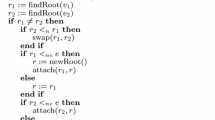Abstract
Quadtree representation presents many advantages in image analysis because of its better manipulation at different scales. In computer vision one frequently faces the problem of multi-scale analysis. We use a syntactic representation of quadtree to analyse images in the Haar base with pyramidal algorithms in linear time. We present applications in dynamic filtering, in compression and image segmentation.
Similar content being viewed by others
References
H.J. Aantonisse, “Image segmentation in pyramids,” Comput. Graphics Image Process., Vol. 19, pp. 367–383, 1982.
D.J. Abel, “A BC-tree structure for large quadtree,” Comput. Graphics Image Process., Vol. 27, pp. 19–31, 1984.
A.J. Danker and A. Rosenfeld, “Blob Detection by relaxation,” IEEE Trans. Patt. Anal. Mach. Intell., Vol. PAMI-3, No. 1, pp. 79–92, 1981.
I. Debauchies, “Thewavelet transform, time-frequency localisation and signal analysis,” AT&T Bell Laboratories, 600 Mountain Avenue Murray Hill, NJ 07974.
R. Gabriel, “Étude de transformées fonctionnelles appliquéesà la compression d'images (Algorithmes, Architectures associées),” Thèse 3e cycle Université d'Aix Marseille, 1986.
A. Gagalowicz and O. Monga, “Un algorithme de segmentation hiérarchique,” in Proc. 5e Congrès RFIA, Grenoble, 1985, pp. 163–177.
I. Gargantini, “An effectiveway to represent quadtrees,” Comput. Graphics Image process., Vol. 25, No. 12, pp. 905–910, 1982.
A. Grossman, “Wavelet transform and edge detection,” Centre de Physique Théorique, Section II, CNRS Luminy case 907.
A. Grossman and J. Morlet, “Decomposition of Hardy functions into a square integrable wavelets of constant shape,” SIAM J. Math. Anal., Vol. 15, No. 4, 1984.
R.M. Haralick and L.G. Shapiro, “Survey in image segmentation techniques,” Comput. Graphics Image Process,Vol. 29, pp. 100–132, 1985.
S.L. Horowitz and T. Pavlidis, “Picture segmentation by a tree traversal algorithm,” Journal Ass. Comput.Mach.,Vol. 23, No. 2, pp. 368–388, 1976.
P.G. Lemarie and Y. Meyer, “Ondelettes et Bases Hilbertiennes,” Centre de Mathématiques de l'Ecole Polytechnique, U.A CNRS No. 169, 1985.
S.G. Mallat, “Multiresolution approximation and wavelets,” MS-CIS 87-87 GRASP LAB 80, 1987.
S.G. Mallat, “Atheory for multiresolution signal decomposition: The wavelet representation,” IEEE Trans. Patt. Anal. Mach. Intell., Vol. 11, No. 7, pp. 674–692, 1989.
Y. Meyer, “Les ondelettes,” Université de Paris-Dauphine, Ceremade.
O. Monga, “Segmentation d'image par croissance hierarchique des régions,” Thèse de doctorat université de Paris Orsay, 1988.
T. Pavlidis, Structural Pattern Recognition, Springer-Verlag: New York, 1977.
H. Samet, “The quadtree and related hierarchical data structures,” Computing Survey, Vol. 16, No. 2, 1984.
H. Samet, The Design and Analysis of Spatial Data Structures, Addison-Wesley: New York, 1990.
J.R. Tapamo, “Segmentation d'images et modelisation quaternaire des formes,” Thèse de Doctorat de l'Université de Rouen, 1992.
Author information
Authors and Affiliations
Rights and permissions
About this article
Cite this article
Tapamo, JR. Multi-Scale Image Analysis by Pyramidal Algorithms. Journal of Mathematical Imaging and Vision 10, 87–95 (1999). https://doi.org/10.1023/A:1008378818203
Issue Date:
DOI: https://doi.org/10.1023/A:1008378818203




